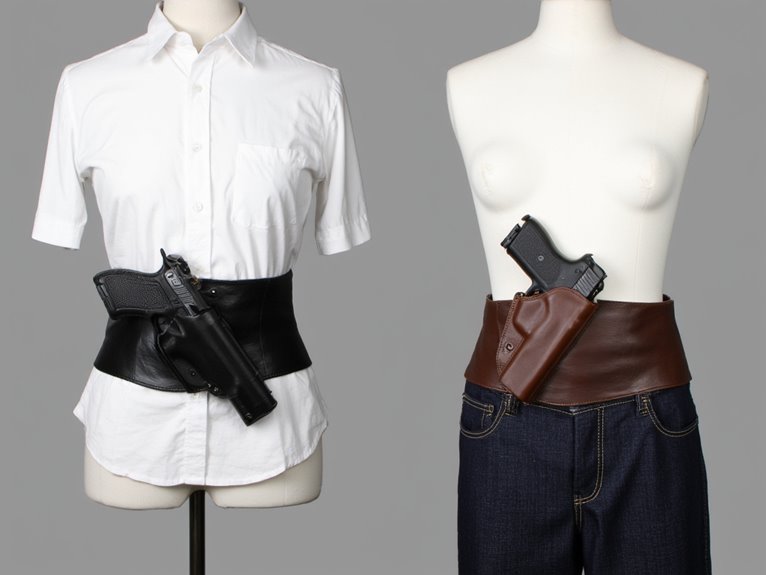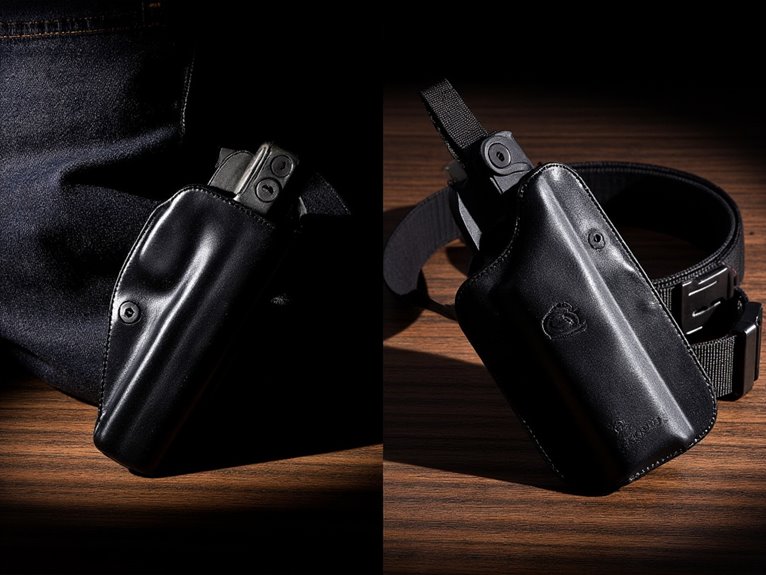IWB vs. OWB Holsters: Which Is Better for Concealed Carry?
IWB holsters excel at concealment by positioning your firearm between your body and waistband, making them ideal for smaller firearms under 6 inches and professional environments requiring deep concealment. OWB holsters offer superior comfort and faster draw speeds by mounting outside your pants, better accommodating full-size firearms over 7 inches. Your choice depends on priorities: IWB maximizes discretion but creates pressure points, while OWB provides accessibility and weight distribution but requires careful clothing selection to prevent printing and maintain concealment effectiveness.
We are supported by our audience. When you purchase through links on our site, we may earn an affiliate commission, at no extra cost for you. Learn more. Last update on 13th November 2025 / Images from Amazon Product Advertising API.
Notable Insights
- IWB holsters offer superior concealment with multiple fabric layers, making them ideal for urban professionals and deep concealment scenarios.
- OWB holsters provide faster draw speeds and easier access due to unobstructed positioning outside the waistband.
- IWB creates more discomfort from direct skin contact and weight concentration, while OWB distributes weight naturally across the belt.
- IWB works best for small to medium firearms under 6 inches, while OWB better accommodates full-size firearms over 7 inches.
- Seasonal conditions favor IWB in warmer weather for concealment and OWB in cooler weather when layering with jackets is possible.
Understanding IWB and OWB Holster Basics
Two primary holster configurations dominate the concealed carry market: inside-the-waistband (IWB) and outside-the-waistband (OWB) designs. Each serves distinct tactical purposes with measurable performance differences.
IWB features include positioning your firearm between your body and waistband, maximizing concealment effectiveness. You’ll secure the holster inside your pants using clips or loops that attach to your belt. This configuration requires clothing adjustments, including larger waist sizes and adequate belt support systems.
IWB holsters maximize concealment by positioning firearms between your body and waistband, requiring proper belt support and clothing adjustments.
OWB advantages center on external belt attachment, positioning your firearm outside your pants. You’ll experience faster draw times and enhanced comfort during extended wear periods. The holster mounts directly to your belt surface, eliminating pressure points against your torso. OWB holsters distribute weight across the beltline, reducing direct pressure on the body for improved comfort during long periods on your feet.
Both configurations accommodate various carry positions, with IWB typically favoring 3-5 o’clock placement for ideal concealment. IWB holsters work best with small- to medium-sized guns, while OWB configurations accommodate larger pistols more effectively. While these waistband options dominate the market, shoulder holsters provide an alternative carry method that offers versatility for different body types and situations.
Concealment Capabilities and Printing Considerations

When evaluating concealment effectiveness, IWB holsters deliver superior performance by positioning your firearm inside the waistband where fabric layers naturally obscure the weapon’s outline.
This inside-the-waistband placement creates multiple concealment layers between your gun and observers. OWB holsters sit externally, making printing more likely without additional clothing coverage like jackets or untucked shirts.
Effective concealment techniques depend heavily on your clothing choices and holster positioning. IWB holsters keep your firearm close to the body, which enhances concealment while maintaining accessibility.
IWB carry works exceptionally well with compact handguns, while larger firearms challenge concealment capabilities. Printing prevention requires careful attention to cant angle and ride height adjustments. OWB holsters provide quicker access to your firearm compared to IWB configurations, making them advantageous for situations requiring rapid deployment. High-quality materials like Kydex construction resist wear and ensure consistent retention performance over extended use.
- IWB holsters reduce printing through natural fabric absorption against your body
- OWB carry demands loose, layered garments for adequate firearm concealment
- Appendix IWB positioning offers deepest concealment but varies in comfort levels
- Thick clothing materials better hide OWB profiles compared to thin fabrics
Comfort and Wearability for Extended Carry
While concealment capabilities often dominate holster selection discussions, comfort becomes the deciding factor for carriers who wear their firearm daily for extended periods. IWB holsters create direct skin contact, causing pressure points and chafing during extended wear.
You’ll experience increased discomfort when sitting, as the firearm presses against your body inside the waistband.
OWB holsters eliminate these wearability factors by positioning the firearm outside your waistband. This external placement reduces skin irritation and allows easier repositioning throughout the day.
Holster comfort depends heavily on material selection—leather offers softer contact but increased bulk, while Kydex provides slimmer profiles with rigid surfaces.
Your belt quality greatly impacts both styles’ wearability.
Hybrid designs attempt balancing comfort and retention, combining leather backing with Kydex shells for ideal daily carry performance. Consider breathable materials like neoprene for enhanced comfort during extended wear, as proper moisture management prevents skin irritation and maintains optimal carrying conditions throughout the day.
Draw Speed and Accessibility Factors
Speed becomes the critical determining factor when seconds count in defensive situations. OWB holsters deliver faster draw speeds due to unobstructed access, while IWB holsters require clearing cover garments first. This adds measurable time to your defensive response.
You’ll face accessibility challenges with IWB designs when wearing layered clothing or fitted garments that complicate rapid clearance.
- OWB holsters enable immediate firearm access without garment interference
- IWB holsters sacrifice speed for superior concealment capabilities
- Clothing type directly impacts draw performance from concealed positions
- Re-holstering proves safer with visible OWB holster mouths
Training improves draw techniques for both systems, but physical limitations remain. You can minimize the speed gap through consistent practice, yet OWB holsters maintain inherent advantages.
Your clothing choices and carry environment ultimately determine which system best serves your accessibility needs. Modern concealed carry pants feature strategically placed pockets that can provide easier firearm access while maintaining discretion compared to traditional clothing options.
Wardrobe Requirements and Clothing Compatibility
Your clothing choices fundamentally determine which holster system works best for your concealed carry needs.
IWB holsters require pants one size larger to accommodate bulk inside the waistband. You’ll need longer shirts or untucked styles to cover the grip effectively. Tuckable clips allow compatibility with business attire while maintaining concealment.
OWB holsters demand intentional layering with jackets, hoodies, or flannel shirts. The outward firearm profile requires bulky outerwear for effective concealment. Different wardrobe styles suit each system distinctly.
Fabric choices considerably impact printing visibility. Loose, heavy fabrics work best with OWB systems, breaking up the firearm’s outline.
IWB holsters perform better under lightweight garments that drape naturally. Tight or thin fabrics increase detection risk regardless of holster type. Seasonal considerations favor IWB during warmer months and OWB when layering occurs naturally.
For those seeking maximum flexibility in clothing options, belly band holsters offer an alternative that works well under various garment types without requiring specific wardrobe adjustments.
Firearm Size and Type Compatibility
Your firearm’s size and weight directly determine which holster type will work best for your carry needs.
Compact pistols under 6 inches in length typically excel in IWB configurations, while full-size firearms measuring 7+ inches perform better in OWB setups due to comfort and accessibility factors.
Weight distribution becomes critical when you’re carrying heavier guns over 30 ounces, as proper retention systems must balance security with quick access regardless of your chosen carry method.
For those prioritizing maximum concealment over quick access, ankle carry holsters provide an alternative carry position that accommodates various popular firearm models while offering enhanced discretion.
Compact Vs Full-Size
When selecting between IWB and OWB holsters, your firearm’s size directly impacts concealment effectiveness, comfort, and accessibility.
Compact carry offers superior concealment advantages with IWB holsters due to reduced printing and smaller footprints. These firearms sit deeper inside your waistband, creating minimal visibility under untucked shirts.
Full size carry presents challenges with IWB positioning, requiring longer shirts and stronger belts to manage the increased bulk.
OWB holsters accommodate full-size firearms more comfortably since they don’t press against your body during extended wear.
However, concealment becomes more difficult regardless of gun size when carrying outside the waistband.
- Compact pistols reduce pressure points when seated in IWB holsters.
- Full-size guns require reinforced holsters for secure IWB retention.
- OWB carry enables faster draws with both firearm sizes.
- Larger firearms benefit from improved airflow with OWB positioning.
Weight Distribution Factors
Weight distribution fundamentally affects carry comfort and effectiveness, with firearm mass creating distinct challenges for both IWB and OWB systems.
OWB holsters distribute weight naturally across your belt and hip area, reducing concentrated pressure points that cause discomfort during extended wear. The firearm’s mass sits outside your waistband, minimizing direct body contact and associated pressure.
IWB holsters concentrate weight inside your waistband, creating pressure points against your body. This becomes particularly noticeable when sitting or bending, as the firearm presses into your abdomen or hip. Heavier pistols amplify this effect considerably.
Your firearm’s size directly impacts weight distribution effectiveness. Full-size firearms perform better in OWB configurations, while compact models suit IWB carry.
Proper holster padding and belt support help mitigate weight-related discomfort regardless of carry method.
Retention System Options
Retention systems differ greatly between IWB and OWB holsters, with each design optimized for specific firearm sizes and carry requirements.
IWB holsters primarily use friction retention efficiency, relying on body pressure and tight tolerances to secure your weapon. These systems work exceptionally well with compact and subcompact pistols but struggle with larger firearms.
OWB holsters employ advanced retention mechanism types including thumb breaks, hood systems, and Level II/III security features. They accommodate full-size pistols and duty weapons more effectively.
Key retention differences include:
- IWB holsters use adjustable retention screws for customizable draw resistance
- OWB designs integrate multi-point retention systems with mechanical locks
- Friction-based systems excel with slim-profile firearms in concealed applications
- Active retention mechanisms better suit heavier, high-capacity pistols requiring stronger security
Choosing the Right Holster for Your Lifestyle and Carry Needs
The crossroads between IWB and OWB holsters represents one of the most critical decisions you’ll make in your concealed carry journey. Current holster trends emphasize lifestyle alignment as the primary selection criterion.
Your daily environment determines concealment requirements—urban professionals need deep concealment that IWB provides, while outdoor enthusiasts may prioritize OWB’s quick accessibility.
Body type considerably influences comfort and functionality. Larger individuals typically find OWB holsters more comfortable for extended wear, while slimmer users achieve better concealment with IWB designs.
Activity level matters equally—static office work suits IWB carry, but dynamic movement favors OWB stability.
For situations requiring extended sitting, belly band holsters offer exceptional comfort and accessibility while maintaining secure retention across various body positions.
Consider employing multiple holsters for different scenarios. IWB for professional settings, OWB for range training or outdoor activities.
Your wardrobe flexibility, carry priorities, and physical comfort ultimately determine the ideal choice for your specific needs.
On a final note
You’ll find both IWB and OWB holsters excel in different scenarios. IWB holsters provide superior concealment for everyday carry, while OWB offers faster draw times and greater comfort during extended wear. Your choice depends on specific factors: body type, firearm dimensions, daily activities, and local carry laws. Consider your primary carry environment, clothing preferences, and comfort tolerance. Test both styles with your specific firearm before committing. The right holster matches your lifestyle requirements perfectly.

